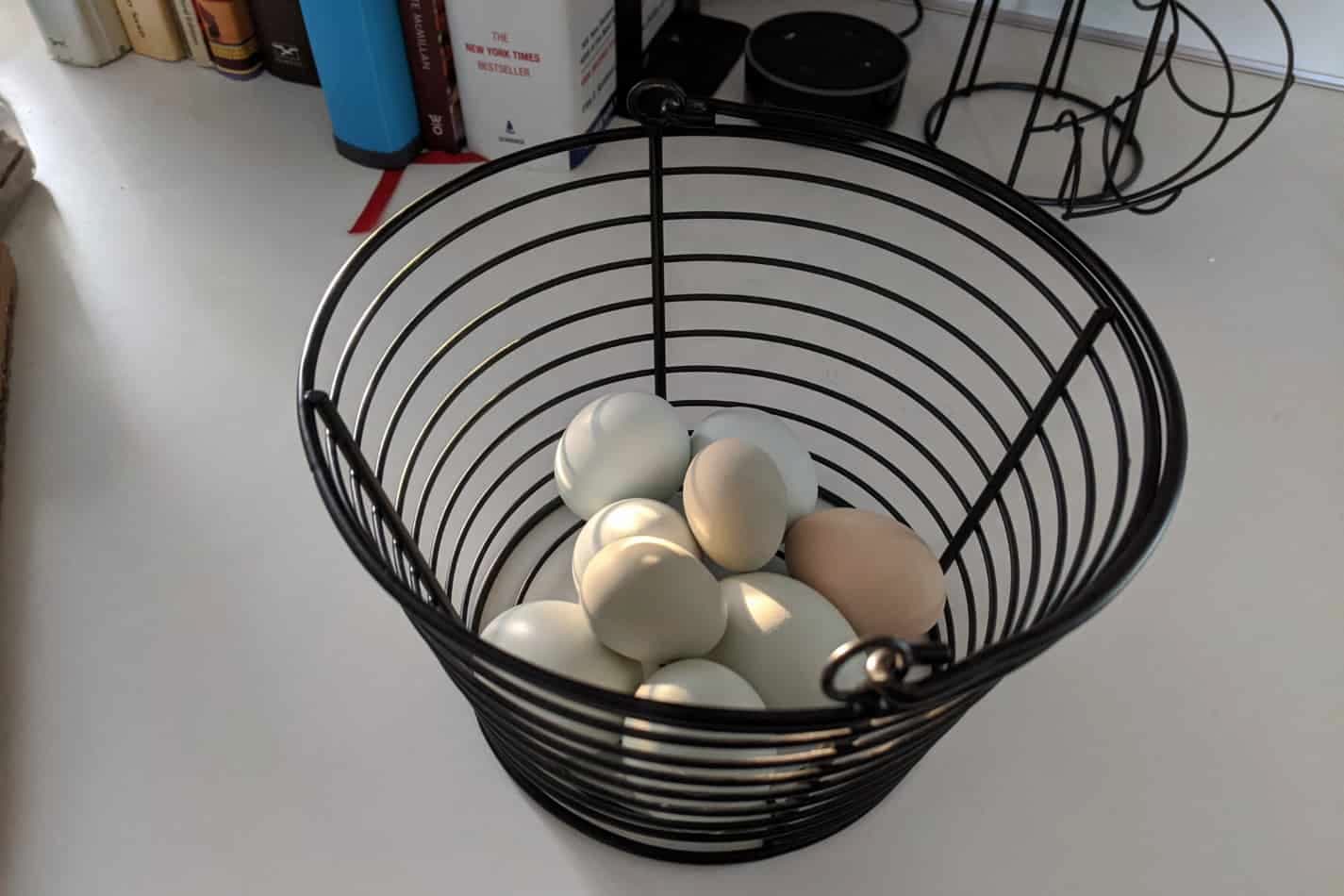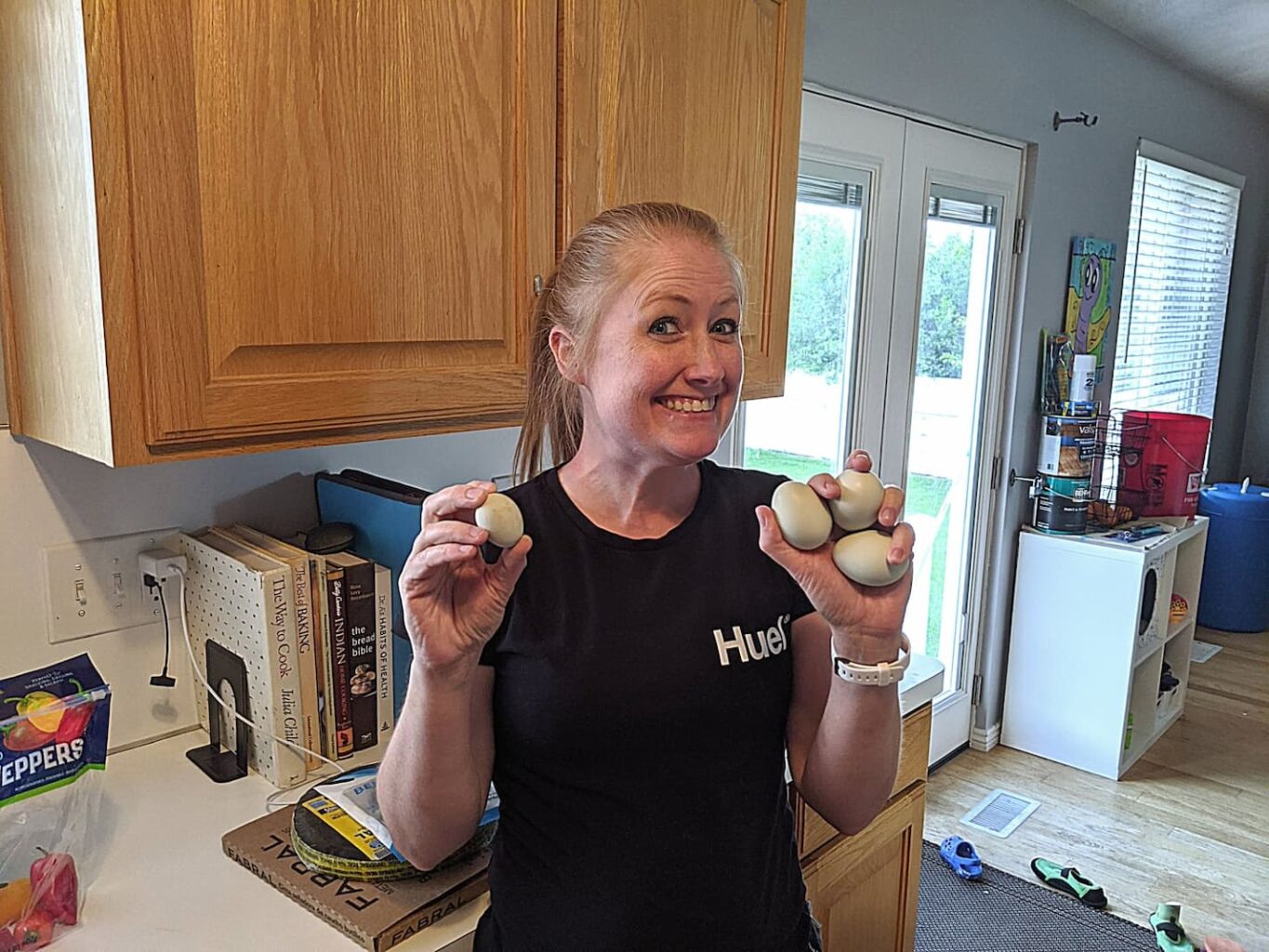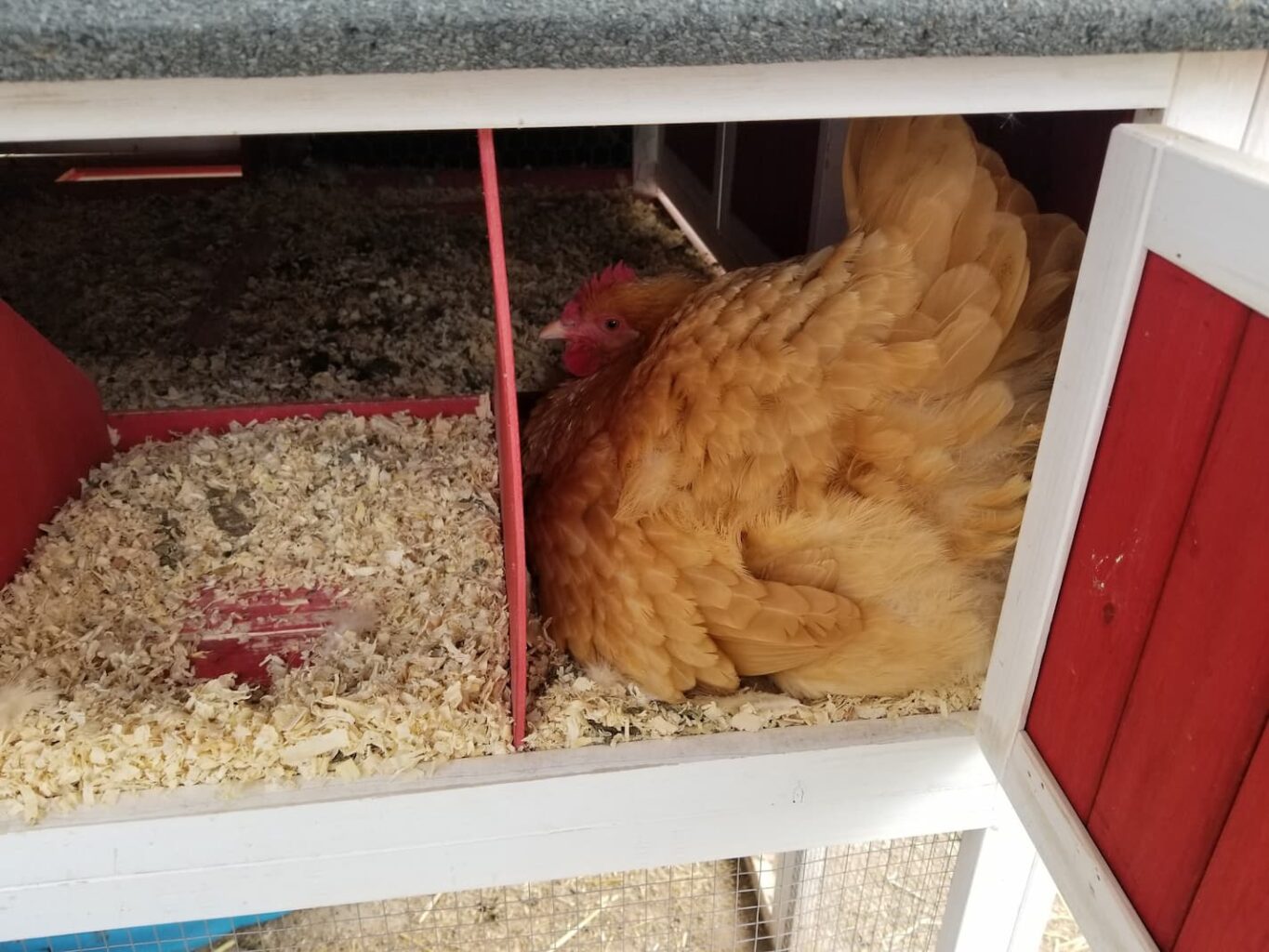One of the best parts of raising chicks into chickens is knowing that delicious eggs can be collected – as soon as the chicks become laying pullets, anyway. And finding that first, small egg is exciting. But how long will those eggs stay small?
First-year chickens (called pullets) can lay eggs as early as 15 weeks old. The earliest, smallest eggs laid are called pullet eggs. Pullet eggs will be inconsistently laid and stay petite until the chicken’s body has fully matured, which can be anywhere between 16-24 weeks of age.
The chicks we got earlier this year have hit this age range – and they’re laying pullet eggs. It’s a lot of fun to collect these bitty eggs. And did I mention that they’re delicious? Keep reading – and let’s give you the complete guide to pullet eggs!

This is How Long Chickens Lay Small Eggs (Pullet Eggs)
Small eggs wouldn’t be a forever thing – well unless you got bantam chickens. Then you’re always going to have small eggs. But pullet eggs are a blip in the egg timeline for every other kind of chicken.
You’ve probably only got a few weeks where you can hope to collect pullet eggs. Notice I said hope and not expect. Not all first-year chickens will lay pullet eggs (but we’ll talk about that later).
How long is that window of potential pullet eggs? It can be up to about eight weeks long, depending on how old your pullets are when they lay their first egg.
The earliest-laid egg I’ve ever seen was for a 15-week-old pulley (15 and 1/2, actually). And, to be transparent, I’m not exactly sure how old that chick was when we got it from the farm supply store. The chick looked only a couple of days old – but she could have been up to 5 days old or so. So if she was on the more mature end of things, then she was 16 weeks old when she laid her first egg.
And in my defense, the very-experienced-with-chickens employees who helped me collect the chicks weren’t exactly sure how old the chicks were, either. They were guessing 2-5 days old, too!
In any case, 15-16 weeks old is the earliest you’ll probably see a pullet egg.
Here’s me holding the first pullet egg of this season in my right hand – with 3 regular-sized eggs from my 2nd-year chickens in my left hand. I’m just a tad bit excited! These eggs are so delicious!

Given what I know of chickens (and my crazy amounts of research), I fully expect to see the occasional pullet egg for up to another 2 months. This is because my pullets started laying on the earlier end of the two-month window.
If your first-year chickens don’t start laying until closer to 20 weeks (like our first batch of chickens – who are now well-established laying hens did when they were pullets), then your window for collecting pullet eggs will be much shorter. It’ll probably only be for about a month.
Now, just because you’ve got a larger (or smaller) window for being able to collect pullet eggs doesn’t mean you’ll get one every day. Pullets lay much more irregularly than established layers do. We’ll talk about this in a minute – I just wanted to make note of it now so that you don’t get your expectations out of whack.
But before we get into that, let’s talk about why your pullets aren’t laying full-sized eggs – yet.
What Size Are Pullet Eggs?
Pullet eggs generally start at half the size of regular eggs. As pullets get larger, their eggs will get larger until they reach their full size.
- Our chickens lay eggs that average 55-60 grams per egg, which qualifies them as “large” eggs.
- Our pullets lay eggs that average 25-30 grams (usually 27 grams) per egg, which puts them in the “peewee” size of eggs.
They really are cute. And if you’d like to see me weigh some of our pullet eggs, make sure you check out this video I did on pullet eggs (or click the image to open YouTube in a new window).

Here is Why Chickens Lay Small Eggs
Technically, a pullet is any chicken that’s less than a year old. However, I like to think of a pullet as a teenaged chicken. It makes explaining chicken maturation to my children a lot easier because they’re familiar with the term “teenagers.”
So in any case, a chicken starts out as a baby (a chick). As they get older, they turn into teenage chickens (a pullet). And in both species, the transition can get a little bit awkward. At least we humans don’t molt. But that’s a different article for another day.
In any case, a teenage chicken looks a lot like a fully-grown chicken. However, there are a few significant internal differences, just like there are in humans. The main one has to do with a chicken’s pelvic bone structure.
In a pullet, the pelvic bones haven’t finished settling, so the biggest egg that can be laid is much smaller. Once the pullet has finished maturing (usually by 24 weeks old) to its full size, those pelvic bones will open up and allow for a larger egg to be laid.
Now, I know that chicken and human anatomy are very different – I am a (people) registered nurse, after all. But hopefully, the comparison between the two was as helpful for you as it was for me. It helped me better understand why pullets lay small eggs.
So now let’s address the fact that not every chicken starts off laying small eggs.
Do All Chickens Lay Small Eggs to Start?
Not all chickens will lay petite-sized pullet eggs when they first start laying. Some chickens won’t lay as pullets at all – and they’ll go from laying no eggs right to full-sized eggs. Some chickens will lay one or two pullet eggs, while others will lay far more.
It’s just going to depend on your chicken, the time of year (as light affects laying), feed, molting, and other factors like illness, temperament, and whatever else.
Our first chickens only laid about 6 pullet eggs total – about one each. Then they all molted (and quit laying) until they hit full maturation. Then, when they did start laying again, the eggs laid were larger. And each day they got progressively bigger until they reached full size.
Via various forums and chicken groups, I’ve read about other chicken owners who’ve experienced the whole gamut of possibilities. Pullet eggs aren’t a guarantee. They could be rare – or they could be more regular. You won’t know until you get there.
How Often do Pullets Lay Eggs?
Pullets don’t lay as regularly or reliably as seasoned hens do. A seasoned hen can lay an egg a day. I haven’t ever gotten that kind of reliability out of a laying pullet.
We have 6 fully-grown laying hens and 6 pullets. In the first week that my pullets surprised us with eggs, I’ve gotten 2 pullet eggs total. Both were blue, so they came from one or both of our Americauna pullets (the Rhode Island Reds would have laid brown eggs).
But because pullets prefer to lay their eggs in private (all of our chickens like their privacy), I haven’t seen which pullet laid which egg.
In any case, treat each pullet egg like the wonderful surprise it is. They aren’t a guarantee – and they won’t last for very long.
How Do I Get My Chickens to Lay Bigger Eggs?
To get your pullet to lay larger eggs, all you have to do is wait. Once they’ve fully matured, their eggs will naturally get larger.
Okay, so you will have to make sure that they have a sufficient diet, are safe, and stay healthy overall. Because those things could artificially and negatively affect egg size – down to the smaller end of things.
But for a pullet, their eggs will get bigger. You don’t have to worry about it as long as you’re taking care of them in general. Collect their petite eggs and enjoy them. Because within a few weeks or a couple of months at most, you’ll be getting full-sized eggs.
On the other hand, if we’re talking about full-sized chickens that you want to lay bigger eggs… well, then there are two things to consider.
- First, think about if there are any factors that could be causing the eggs to be smaller. We’ll talk about these factors in more depth later, so make sure you check out that section of this article.
- The second thing to consider is this: not all chickens lay super-enormous eggs. Your chicken’s breed has a natural limit to egg size. If you want larger eggs than your chicken can lay – you’re going to need a different (and larger) breed of chicken.
Just remember to take good care of your chickens – and let them lay their eggs. Then you get to enjoy a wonderful animal – and eat some delicious fresh eggs.
Can You Train Pullets Where to Lay Their Eggs?
To a degree, pullets can be trained on where to lay their egg. They naturally prefer to lay eggs in a private location. And chickens all like to lay their eggs together.
So set up a nice, cozy nesting box and do one of two things to train your pullets on where to lay their eggs.
- If you have laying chickens, they’ll train the pullets on where to lay. Let the pecking order work for you.
- If these pullets are your first chickens, you can put a ceramic egg in the nesting box to give them the right idea. This will work best if you have done some previous work to set the nesting box up as a desirable laying location.
To set the nesting box up as a preferred laying location for new pullets, here’s what I did. I got this information from other chicken owners, websites, and books I’ve read. I can’t remember the exact source because it came from several.
- When you set up your chicken coop, make sure it has nesting boxes. Then, wall them off with a piece of sturdy cardboard or something else.
- Introduce your chicks or pullets to the coop. The walled-off nesting boxes will keep them from claiming those as a sleeping (or pooping) area. This will keep them separate and premium.
- Once your pullets are adjusted to their coop and close to laying, remove the barriers to the nesting boxes. If you’re going to add a ceramic egg, this is the time to do it.
- Give your pullets a couple of weeks to get used to the new space – and to identify the nesting box as the desired spot to lay their eggs.
- Wait, watch, and see.
- Remember that chickens are going to all lay in the same spot – and sometimes they pick a different spot than you did.
This worked really well for us last year with our first batch of chickens. And this year, the established hens are teaching the pullets where to lay. It’s pretty awesome.

Other Factors that Affect Egg Size – at Any Age
There are a few factors that will affect egg size, no matter your chicken’s age. Let’s go over them now – along with what you can do to help make sure your chickens are healthy and able to lay the best eggs possible.
| Factor | Rationale | Examples |
|---|---|---|
| Chicken breed | The overall size of the chicken will impact the egg size. | Bantams lay bitty eggs. Big chickens lay big eggs. |
| Health | Healthy chickens can lay full-sized eggs. | If your chickens get worms or mites, egg size and production will be lessened. |
| Stress | Happy chickens lay eggs. | Chickens who are stressed by predators or other things will lay smaller eggs less frequently. |
| Feed | Laying hens need proper protein to maintain laying. | Feeding laying hens too many treats (scratch) may lower the protein enough that production or egg size decreases. |
| Water | Chickens need fresh water to lay eggs. | Insufficient water affects stress levels and egg production. |
| Sunlight | Laying eggs is related to adequate sunlight (or artificial light). | Chickens lay smaller eggs less frequently in wintertime unless they’re given supplementary light. |
Oh, and a quick note about stress. Chickens are funny creatures. Because while my kids play with the chickens and chase them, that doesn’t seem to cause them too much stress. They still lay pretty regularly – at least the full-grown hens do. The pullets aren’t at that stage yet, so I don’t worry about them.
So as long as your chickens have a safe place to live that’s predator-proofed, you’re generally okay. Just cut them a little bit of slack for a day or so if a hawk gets too close – or if a neighbor’s dog gets into the yard.
Pullet Eggs: Small but Safe to Eat (and totally delicious)
A question that gets asked pretty regularly is if those small pullet eggs are safe to eat. The answer is this: if the pullet egg looks just like a miniature egg, it’s a miniature egg – and totally safe to eat. If in doubt, crack it open to see.
We’ve eaten all but one of our pullet eggs. And the one we didn’t eat was because it was so cute that we were passing it around – and we dropped it on the floor. Our dog cleaned that mess up. He was more than happy to do that!
I’ve read about various chefs who actually prefer pullet eggs – and say they’re even more delicious than regular eggs. While I’m no chef (and I think our chicken’s regular eggs are delectable), I definitely agree that the pullet eggs are delicious.
We’ve tried them scrambled and hard-boiled so far, with plans to try cooking them in other ways. But so far, both ways we have tried are absolutely delicious.
Related Questions
Why Are My Chicken’s Eggs Getting Smaller? Fully grown chickens may experience a slight but natural decline in egg size in their second year. Other causes of more drastically decreased egg size are changes in protein intake, illness, and stress.
How Long do Chickens Lay Eggs? Chickens naturally lay eggs in direct correlation to the sunlight they get. If winter is dark and cold, giving them an artificial light source can boost winter egg-laying, though doing so can shorten the hen’s overall lifespan. Chickens lay eggs for life, though the daily reliability of laying eggs does change as they age.
How Long Do Chickens Live? Chickens can live as long as 20 years, though a more usual life expectancy is more like 8-10 years. For more information on the 5 most important factors that will impact your chicken’s life expectancy, read my article on it here.
